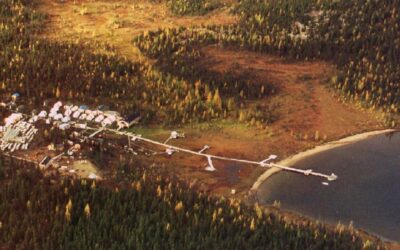COVID-19 Recovery series
As the country moves towards economic recovery from the pandemic, the Institute considers the policy choices ahead for Canada.
While some have seen the reduction of greenhouse gases and air pollution resulting from a pandemic-driven pause in economic activity as a possible longer-term solution, others have been calling for a halt to climate change policies in the face of a massive economic shock. Neither is good policy.
We can’t lose sight of longer-term policy challenges such as climate change as we deal with immediate needs. In fact, pandemic preparedness has been considered a long-term challenge for decades, with significant uncertainty as to the timing and nature of an event. We also shouldn’t see economic growth and climate policy as trade-offs. The best outcomes for Canadians necessitate finding ways to address both simultaneously.
Stopping Economic Growth is No Way to Address Climate Change
Reductions in greenhouse gases resulting from restrictions on economic activity are temporary. Once normalcy returns, emissions will start climbing again. The best lasting solution to climate change depends on finding ways to achieve emission reductions while the economy is growing, not finding ways to slow economic growth.
The COVID-19 pandemic has shown the personal consequences of reduced economic activity. It is not just large, faceless corporations affected, but real people who are losing their jobs and incomes. In fact, the most vulnerable members of society often bear the brunt of economic shocks.
Historically, economic growth has brought many benefits to society, including lifting billions of people out of poverty worldwide. Without growth, we would not have seen myriad health innovations, such as heart bypass operations, vaccines for devastating disease, and antibiotics. Strong economies can afford to invest in research and development and have well-developed private sector financing to commercialize and distribute new products. Other innovations that have become critical to our daily lives, such as cell phones, cars, and dishwashers, would not exist without the drive of private companies to grow. We are just at the beginning of a revolution to our wellbeing caused by the myriad applications of artificial intelligence.
To address global challenges, the world needs these innovations to continue, and even accelerate. Companies around the world are now working feverishly to develop treatments and vaccines for COVID-19 that will save lives. Their expertise and capacity would not exist without a financial motivation to develop new products. Innovation is also critical to addressing climate change. Continued cost reductions in renewable energy and electric vehicle batteries are driving increased adoptions around the world. And new and emerging innovations are promising emission reduction game-changers.
Economic growth always has some negative side effects along with its positive benefits. In some regions, it has resulted in rising income inequality, with the benefits of growth felt more by those at the top than those at the bottom. Economic growth has also come with environmental damage, including air pollution, loss of nature, and climate change. Yet these negative side effects do not justify stopping growth. Instead, they underscore the need for government policies that address side effects while retaining the benefits of growth, such as those achieved over the last century. Many of the technologies to address climate change already exist; all we need is the will to use them fully.
Stopping Climate Action is No Way to Stimulate Economic Recovery
The call to shelve climate policy to support economic recovery is equally short-sighted. It is in Canada’s long-term economic interest to reduce the dependence of our economy on greenhouse gas emissions and develop sources of economic growth consistent with a low-carbon world. Delay will only mean higher costs down the line. That doesn’t mean that we should blindly push ahead during a crisis, however. Some policies may need to be temporarily adjusted or supplemented to protect Canadian businesses and individuals that are struggling.
The challenges facing Canada’s oil sector, for example, can’t be solved with a one-time cash injection or a pause in carbon pricing. Even if oil demand and prices recover in the next year or two, the long-term outlook remains a concern. Governments can help the sector get through the current crisis, but there is little they can do to control global trends. The recent battle between Russia and OPEC shows that low-cost producers hold all the cards. Global climate change policies, and shifting investor preferences, will make it increasingly difficult for producers that are also emissions-intensive to compete.
Many of Canada’s oil and gas companies are large organizations with highly skilled employees. They have the capacity to innovate to reduce per-barrel costs and emissions, and to diversify product lines and explore new market opportunities, such as hydrogen and geothermal energy. They will do this in search of profits – cutting costs on existing products and selling new ones. However, the speed of transition will be challenging – particularly with a substantial near-term decline in revenues and underdeveloped markets for emerging energy sources. Their efforts can be encouraged through government policy.
Once the end of the short-term crisis is in sight, governments will consider investments to support economic recovery. Measures could include financing or incentives for transition-related projects that support both economic and climate objectives. At the same time, expanded financing for new companies in low-carbon sectors such as cleantech, health-tech, and services can spark new sources of sustainable growth and diversified jobs.
A changing climate is itself an economic risk – a risk that is growing over time. With climate change, we are already seeing the devastating impacts of wildfires and flooding, and the growing health impacts of heatwaves and Lyme disease. Government policies must play a key role in helping Canadian businesses, communities, and individuals prepare for a changing climate, reducing the risk to Canada’s economy.
We Don’t Have to Choose
There has always been a tension between near-term and long-term policy challenges. Governments must address immediate needs to the best of their ability. Right now, their focus should be on helping households and businesses build a bridge to the other side of the crisis.
But if governments lose sight of the looming challenges ahead, they risk being caught in a never-ending cycle of short-term crises. Investment in infrastructure that is neither low carbon nor climate resilient may result in costly stranded assets from global market shifts or extreme weather events. If governments reduce the ambition or momentum of climate policies, investors and entrepreneurs could turn away from promising innovations that would be important sources of growth and jobs in the future. At the same time, Canadians could miss out on important health co-benefits, such as reduced air pollution, that improve resilience to future respiratory disease.
The fact is, we don’t have to choose. There are creative ways to achieve multiple policy objectives, through climate-friendly economic stimulus packages and economy-friendly climate policy packages. We should all have the same goal in mind: ensuring the health, safety, and wellbeing of Canadians today, while building a better future for our children and grandchildren.
COVID-19 Recovery – More of this series





